CAG shows several gaps in GST regime
The Comptroller and Auditor General (CAG) has pointed to several gaps in the goods and services tax (GST) regime, including problems with the refund mechanism as well as with the filing system and failure of the IT platform provider GSTN in checking the filed data.
Refunds have come in for special scrutiny with the CAG report, which dealt with FY21, noting that there were instances of non-compliance with the rules, with the provisions in cases where refunds were paid and the department did not use its own database for the purpose. Similarly, it noted that officers failed to scrutinise cases where suspicious refund claims were not supported by adequate documents.
The government sought to counter it saying that during the initial phase the focus was on “facilitation” instead of “enforcement”.
There were also instances of double refunds in cases where claims were made at the central as well as state level and several cases of delay in clearing the refunds were also noticed.
Based on the audit, the CAG has recommended a comprehensive profiling of the taxpayers by integrating data from internal and external systems such as income tax, DGFT and the ministry of corporate affairs. It also suggested a real-time system for red-flagging of high-risk taxpayers to avoid refunds of fake ITC (input tax credit), something that the department is already working towards. Similar steps have also been proposed for those engaged in overseas trade.
Pointing to delays in the rollout of simplified returns and the GST Council’s repeated extension to GSTR-3B, the CAG report said, “Audit… is of the opinion that additional steps need to be taken to fully address the issue of non-intrusive e-tax system and system-verified flow of ITC based on the principles of invoice matching.”
It also noted that until March 2021, the government had failed to put in place an effective risk-based system of scrutiny of returns even three years after the rollout of GST.
The CAG was particularly unhappy with the GST authorities for not sharing data on high-risk taxpayers, which are shared with field officers for action as the finance ministry argued that they were in the nature of “intelligence reports” for targeted enforcement and could not be disclosed.
The report pointed out that there were several instances of taxpayers neither being monitored by the Centre or the states as there was a formula to allocate each taxpayer to one of the authorities. It also pointed to several inconsistencies in the data maintained by GSTN the company providing the IT backbone.
For example, there were gaps between taxable value and declared tax liability. There was a difference between the state and central GST paid on a transaction although the levy is equal.
Group cover cost PSU insureres Rs 26k cr
The four public sector insurance companies New India Assurance, National Insurance, Oriental Insurance and United India Insurance lost Rs 26,364 crore in the five years between FY17 and FY21 due to losses in their health insurance portfolio. A report by the Comptroller and Auditor General (CAG) on the audit of the health insurance business of public sector insurance companies has said that group health insurance business has either wiped out profits or increased losses of other lines of business.





